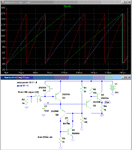rudr_p
Member level 1

Hi, I need a sawtooth wave of +/-15v(little less than that will also do) of about 12khz or more. the two op amp circuit (schmitt trigger and integrator method) but will it work with lm324 or 339 opamp?................. another option I see is 555 ic timer for as square wave generator and opamp. I have +/- 15v available.
is there another method to obtain the waveform?
is there another method to obtain the waveform?




